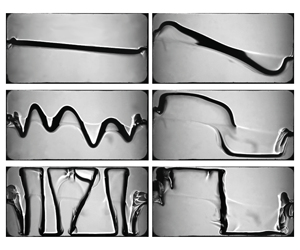Article contents
Effect of initial interface orientation on patterns produced by vibrational forcing in microgravity
Published online by Cambridge University Press: 17 December 2019
Abstract

When a container with two distinct fluids is subjected to vibrations in microgravity, the interface may undergo a variety of instabilities and develop towards a complex structure, as seen in recent parabolic flight experiments using both miscible and immiscible liquids. Among other things, the selected pattern depends on the frequency and amplitude of the forcing and, crucially, on its orientation with respect to the initial interface. In a parabolic flight experiment, this initial orientation is largely determined by the stage of the parabolic manoeuvre when the forcing is started and the residual gravity level during the period of microgravity. It plays a key role in the appearance of defects and irregularities during the evolution of the interface triggered by the frozen wave instability. Using numerical simulations, we systematically investigate the effect of initial interface orientation on pattern selection in microgravity for both miscible and immiscible fluids, and compare to available experiments. When the interface and the forcing are nearly aligned, the frozen wave instability is dominant, leading to the development of approximately regular columnar patterns. As the initial angle becomes more oblique, the frozen wave growth becomes more irregular and asymmetric and may involve thin auxiliary columns. Sufficiently large angles suppress the frozen wave instability and, depending on the container aspect ratio, may result in a simple two-column final state.
JFM classification
- Type
- JFM Papers
- Information
- Copyright
- © 2019 Cambridge University Press
References
- 15
- Cited by


